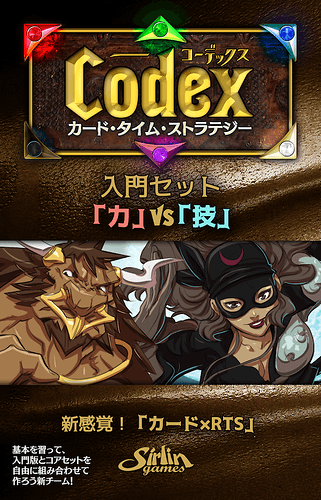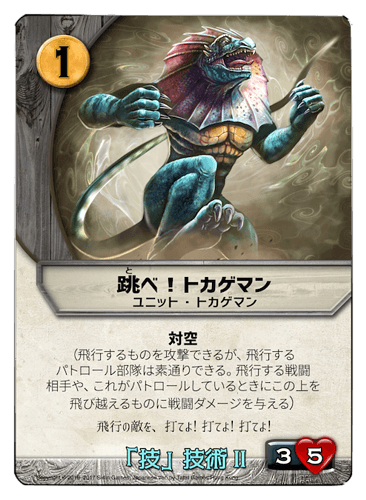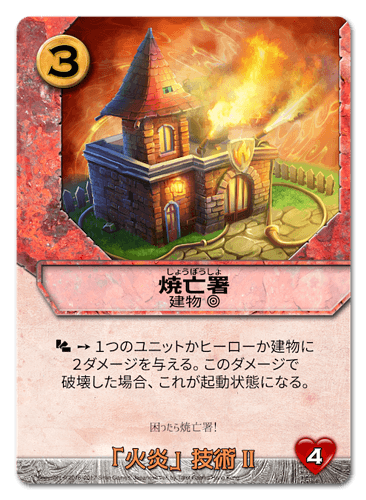I don’t mean to get anyone too excited and worked up but
An official Japanese version of Codex is coming! Right now the goal is to get the Starter and Core sets sent off to the printers by the end of summer. The current status of the translation is “feature-complete but fixing bugs,” which is to say that there is now a Japanese version of everything included in both boxes, but they still need to be gone through with a fine-toothed comb to make sure that we didn’t miss any typos or other issues. All images here are from an incomplete and unfinished version of the game, guys.
If you happen to read Japanese, you may have noticed a few things in those pictures. For one, the Starter set specs are “Strength” and “Skill,” rather than “Bashing” and “Finesse.” There are a couple of reasons for this, the most important being that those two concepts are often presented as “set opposites” in Japanese culture, so it made sense to take advantage of that for a less “translationy” translation.
But what about Rook’s spec, then? Well, broadly speaking, the specs are pretty directly translated from English (with only minor changes here and there, often because English has more finely tuned words than Japanese). The main differences beyond the Starter set are Zane’s spec being named something closer to “Chaos” or “Disorder” than “Anarchy” (since the Japanese word for “anarchy” is either specifically “lack of a government” or “chaos” without the dual meaning of the English) and Bigby’s spec being named “Justice” instead of “Law.”
The biggest change in the spec names is for White. The goal was to keep the feeling of “scholarliness” last seen in Midori’s special move name translations in Yomi, so the White specs are named with four-character compounds: Strength becomes 百練千磨 (literally “100 practices 1,000 polishes”), Ninjutsu becomes 奇想天外 (essentially “completely unexpected”), and Strength becomes 金剛不壊 (essentially “firm and unshakable”).
If you speak Japanese, you may have also noticed that the example cards shown enjoy a bit of wordplay in the translation, in a similar fashion to how the English version has a definite sense of fun to it.
“Firehouse” is perhaps the most straightforward example: the first part of the Japanese word for a firehouse, 消防署, sounds just like the word 焼亡, which means “to be destroyed in a fire.” The net effect of “焼亡署” is more or less identical to the wordplay of the English, if perhaps a bit more direct.
“Artisan Mantis” takes advantage of the fact that readings for all of the kanji characters on the cards’ names are given explicitly. The word for “artisan” is 職人, literally “occupation-person.” The thing is, though… that’s a mantis! In recognition of diversity, the kanji for “person” was changed to the one for “bug” or “insect,” but the reading was left intact to provide a sense of “this is the intended meaning, but expressed in a slightly unusual manner” (which can occasionally be seen in, say, comics).
“Leaping Lizard” was just a huge thorn in our sides for the longest time, because the name and flavor text (“He can reach for the sky.”) are just so cowboy movie in a way that is entirely impossible to translate with any flavor left to them (something like “Jumping Lizard” that’s just sort of… dull). Ultimately, in a moment of epiphany, the idea came to instead double down on localization. As a result, the card is now named “Tobe! Tokageman” (“Jump! Lizardman”) in reference to the theme song from the original Gundam, “Tobe! Gundam” (“Fly! Gundam”), taking advantage of the fact that the words for “jump” and “fly” are pronounced the same in Japanese. For the flavor text, he has another Gundam intro song reference that happens to reinforce his ability as an anti-air unit: it says “Hikou no teki o, ute yo! Ute yo! Ute yo!” (“Strike! Strike! Strike your flying enemy/-ies!”) in reference to the lyric “Kyodai na teki o, ute yo! Ute yo! Ute yo!” (“Shoot! Shoot! Shoot your giant enemy/-ies!”), once again taking advantage of homonyms in Japanese.
Happily, most of the cards have been far more straightforward to create acceptable Japanese translations for them, but then it’s not very interesting to talk/hear about those, now is it? ; )




